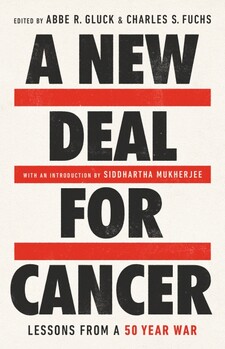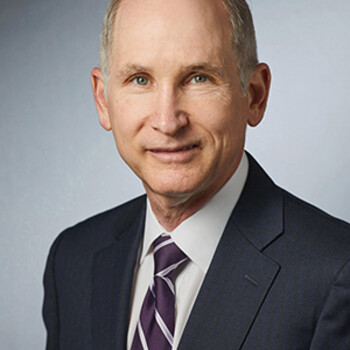Law, Policy, Equity, and the Future of the War on Cancer

Inspired by a 2018 conference on the policy, politics, and law of cancer sponsored by Yale Law School and the Yale Cancer Center, the new book A New Deal for Cancer: Lessons from a 50 Year War examines the successes and failures of the landmark National Cancer Act of 1971 and delves into the half century of advances and setbacks in cancer research, care, access, and policy since President Richard Nixon signed the Act in 1971.

Assembling chapters from leading experts including physicians, policymakers, researchers, and advocates, the interdisciplinary collection highlights the war on cancer’s most pressing issues, focusing on the governance, economics, practice, and equity of cancer treatment and illuminating the legal, regulatory and clinical paths forward.
On the occasion of the act’s 50th anniversary and President Biden’s renewed Cancer Moonshot, Gluck and Fuchs answered questions about the past and present of the war on cancer and what law and policy can do in the ongoing effort to secure further progress in the science, prevention and treatment of the disease, and ensure those advances are accessible to everyone.
Q: Why did you title this book, which marks the 50th anniversary of the National Cancer Act, A New Deal for Cancer? What is the role of law and policy in the “war on cancer”?

Abbe R. Gluck: The National Cancer Act was understandably focused on scientific advancement, and we would not have the luxury of thinking bigger today had the science not been so successful. But we now need to move beyond just the science to achieve more progress. Law and policy have a huge role to play once we adopt a 360-degree lens on the disease.
Just a few examples, among many others: The National Cancer Act did not pay sufficient attention to ensuring that once scientific advancements were made, they were accessible to the entirety of the American people. Equity was not front and center. One tragic irony of our scientific progress is that it has created new disparities even as it ameliorated others. In 1975, Black and white Americans had relatively equal death rates for breast and colorectal cancer; by the early-to-mid 1980s, Black breast and colorectal mortality rates surpassed white rates and that trend has not reversed. A major cause of these disparities is unequal access to screening, diagnosis, and quality treatment, and that’s a problem law and regulation can address.
Relatedly, access to insurance is a significant predictor of cancer outcomes. Until the passage of the Affordable Care Act in 2010, tens of millions of Americans suffered from inadequate, unaffordable, or zero health insurance, little access to screening, and insurance discrimination based on preexisting health conditions, including cancer. The ACA has made an extraordinary difference on those fronts but there are still a dozen states that have not expanded Medicaid under the ACA, leaving millions of low-income Americans uninsured.
Congress has its own critical role to play. Consider the shocking differences between the CDC’s entire budget — which for the 2021 fiscal year totaled nearly $7.9 billion for the entire agency, including not only cancer prevention but all the CDC’s prevention efforts including pandemic response — and the National Cancer Institute’s budget for cancer alone, which was $6.56 billion for the same period. And yet tobacco, obesity, and environmental toxins are major drivers of preventable cancers, and cancer inequities, that Congress has not focused adequately enough on preventing.
Finally — and there is much more we could say — data sharing is critical in the advancement of cancer science in this modern era where genetics has become so central to cancer. Our privacy laws have impeded the optimal level of data sharing for progress.
Law can be an obstacle and law can be a tool.
Q: President Biden recently reintroduced the Cancer Moonshot, including a new plan to halve the death rate from cancer by 2047. How does your perspective on law and policy fit into this effort?
Abbe R. Gluck: Taking a page out of his very effective strategy to fight COVID-19, President Biden emphasized that the reignited Cancer Moonshot requires an all-hands-on-deck approach to meet its goals — and that’s exactly what we are arguing for. It includes addressing inequities across the entire modern cancer continuum and recognizing that the continuum has changed. Survivors need medical and financial support, as do caregivers, with the population of survivors expected to top 22 million by 2030 and a five-year survival rate exceeding 70 percent. Survivors experience a higher prevalence of chronic conditions, some resulting from late and lasting effects of treatment, as well as subsequent cancers.
Law also can help ensure that overlooked cancers are not lost in the shuffle, one of President Biden’s main goals for the renewed Moonshot. We offer examples of successful laws driven through Congress by cancer advocates, including laws promoting the commercialization of cancer drug development for pediatric and other rare cancers for which there may be little financial incentive.
Policies addressing the “business of cancer” could improve where patients receive care, as well as the type of care they receive while bringing coherence to pricing. Community practices have been shuttering, but advances in electronic medical record-sharing mean that everyone should have access to both a local oncologist and the expertise of a large cancer center when needed. Currently, the true cost and value of cancer care is mismatched. Some services that do not generate much revenue but are nevertheless vital, like training new doctors, research, second opinions and palliative care, are cross-subsidized by profits from other services and procedures like chemotherapies, surgeries, and interventional radiology. The reimbursement system creates perverse incentives for overutilizing the latter, partly to support the former. Everyone wants to cut prices, but they can’t be slashed in a vacuum without understanding these connections.
President Biden understands firsthand how COVID-19 has illustrated the power of the Presidential platform in science. The President has the power to galvanize fast-paced research, including public-private sector collaborations, force siloed agencies to cooperate and demand progress on health equity. The point is that we need a broader view of what “counts” as cancer policy — a holistic approach that goes even further than the Obama-Biden Moonshot of 2016.
Q: How can we ensure that new technologies and treatments are available to all patients, especially in historically underrepresented or underserved populations?
Dr. Charles Fuchs: The past 50 years has witnessed meaningful advances in the treatment, early detection, and prevention of cancer. The introduction of immunotherapy, targeted therapies, and precision therapy have revolutionized cancer treatment.

Fifty years ago, advances in cancer treatment were largely a result of testing cytotoxic chemotherapies in patients, relying on a limited understanding of the unique targets in cancer cells. Our growing understanding of cancer biology and the genetic drivers of cancer have enabled more rational design of cancer therapeutics. At the same, our ability to rapidly detect the unique genetic profile of a patient’s cancer now enables far greater precision — so that we can rapidly deliver the right treatment to the right patient. At the same, breakthrough discoveries in immunology have made the promise of cancer immunotherapy a reality. Through various novel approaches, we can now activate the patient’s own immune system to attack the cancer — a revolution in cancer treatment. With these profound advances in science and cancer research, we are progressively accelerating progress in cancer therapy and meaningfully improving the lives of patients.
Nonetheless, as we explain in the book, the idea that a scientific cure, as the only goal of the 1971 National Cancer Act, did not predict the full scope of the problem. The war on cancer was not against a single enemy but countless adversaries, including health inequity.
Progress in cancer therapy cannot be fully realized unless innovations are accessible to all patients. Future clinical trials of novel therapies must ensure that underrepresented patient populations have access to these studies and are enrolled into the trials. Specifically, the patient demographics of clinical trials must, at a minimum, reflect the demographics of the broader, diverse population around us. At the same time, ongoing genetic sequencing studies that seek to improve cancer detection and cancer treatment must similarly expand enrollment to these diverse populations. No less importantly, state-of-the-art cancer therapies must be available to all patients, regardless of race, ethnicity, gender, or socioeconomic status. Ultimately, if we do not eliminate the barriers to widespread access to innovation in cancer biology, prevention, and treatment, real victory in the war on cancer cannot be realized.
Q: What do you hope the next 50 years in the war on cancer looks like?
Dr. Charles Fuchs: The extraordinary breakthroughs that are cause for celebration also identify the challenges that lay ahead. We can celebrate the great scientific and clinical accomplishments since the passage of the National Cancer Act, but we remain a long way from declaring “mission accomplished.” With the advances in prevention and therapy of heart disease witnessed in the 20th century, cancer is now the leading cause of mortality among Americans under the age of 80. Although advances in cancer treatment have significantly improved patient outcomes, many patients do not benefit from the latest cancer treatments, and, even among patients who do benefit, cancer recurrence remains a pervasive issue. Further understanding of the fundamental drivers of cancer biology, the unique subtypes of each cancer, and the mechanisms of treatment resistance, in conjunction with the development of new technologies is needed and must be accelerated.
Resources for cancer prevention and early detection remain inadequate, and we must recognize that our future strategy must include public health interventions alongside effort in scientific research. Data sharing and other collaborations across government, academic institutions, and the private sector must be improved so that we break down existing silos and truly bring all sectors together to join forces to share knowledge and accelerate progress. Furthermore, as stated above, we must eliminate disparities in access to cancer treatment and prevention across all segments of our population.
The challenges and solutions for cancer reflect the larger, fundamental need to accelerate innovation and novel approaches across the gamut of biomedical research — while at the same time, pushing us to think beyond the science to the myriad of other structures and institutions that deliver those innovations to the sick. We call for a New Deal, all-hands-on-deck approach to a multimodal problem that invests for the greater benefit of all.


